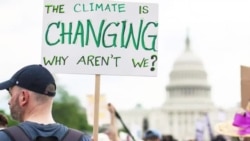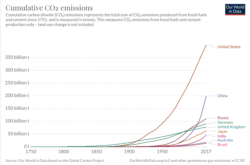Marking his first 100 days in office, President Joe Biden delivered his first address to a joint session of the U.S. Congress on April 28.
Throughout his speech, Biden touted his pandemic recovery plan and ambitious proposals for jobs, gun control, police reform and infrastructure. He also hit on another priority – global warming – bringing up his Leaders’ Summit on Climate the prior week.
“Look, the climate crisis is not our fight alone; it’s a global fight,” Biden said. “The United States accounts, as all of you know, less than 15 percent of carbon emissions. The rest of the world accounts for 85 percent.”
The statement is misleading.
Although Biden is technically correct that the U.S. today accounts for only 15 percent of global carbon emissions, that figure underplays the country’s historical record as the biggest greenhouse polluter.
Furthermore, the U.S. remains the second-biggest emitter of carbon dioxide (CO2) – the primary greenhouse gas emitted through human activities, primarily burning oil, coal and natural gas. China, which ranks number one, accounts for 27 percent of global emissions.
China surpassed the U.S. as the biggest emitter of carbon dioxide in 2006. But from the 1750s until then, the U.S. put more carbon dioxide pollution in the atmosphere than any other country in the world, as seen in the graphs from Oxford University's tracking site Our World in Data.
It is estimated that the U.S. has emitted around 400 billion tons of CO2 – 25 percent of historical emissions – making it one of the countries most responsible for climate change.
Moreover, the U.S. remains one of the world’s biggest producers of CO2 per capita, with more than 16 tons in 2019. China, in comparison, produced 7.1 tons per capita the same year.
Global carbon emissions from fossil fuels have increased significantly since 1900, according to the U.S. Environmental Protection Agency:
Since 1970, CO2 emissions have increased by about 90%, with emissions from fossil fuel combustion and industrial processes contributing about 78% of the total greenhouse gas emissions increase from 1970 to 2011.
Fossil fuels remain the primary energy source in the United States, but their share has declined. In 1966 fossil fuels hit a high, accounting for 94 percent of total energy consumption. By 2017, fossil fuels supplied about 80 percent of the country’s energy, the least since 1902, according to the U.S. Energy Information Administration.
In 2018, Yale Environment 360 reported: “The decline in 2017 marks the third consecutive annual drop in U.S. domestic fossil fuel consumption. The trend is driven partly by a long decline in coal use — 40 percent since 2005, and 2.5 percent in 2017 alone.”
Renewable energy, including hydroelectric, wind, solar and others, accounted for some 11 percent of U.S. energy consumption in 2017.
According to 2020 data, U.S. carbon emissions declined more than 10 percent, the largest drop since the end of the World War II. That drop, however, was partially due to the coronavirus pandemic and still did not meet the goals set by the 2015 Paris climate agreement, under which the U.S. pledged to reduce carbon emissions by 26-28 percent of 2005 levels.
In 2019, the year before the pandemic, the U.S. only reduced emissions by 2.8 percent.
Biden’s predecessor Donald J. Trump pulled the United States out of the Paris accord. Biden reversed that on his first day in office, and his administration has promised to transition the country from fossil fuels into clean energy, while maintaining and creating more jobs for Americans in these industries. (Biden served as vice president under Barack Obama when the Paris agreement was reached.)
During the leaders’ climate summit, Biden vowed to cut U.S. greenhouse gas emissions by at least 50 percent by 2030.
While the administration has pitched that as an aggressive goal, some say the country could be doing more. According to Carbon Switch, an energy efficiency startup, the reductions set out by the Biden administration "would fall far short of those needed to meet the Paris agreement."








